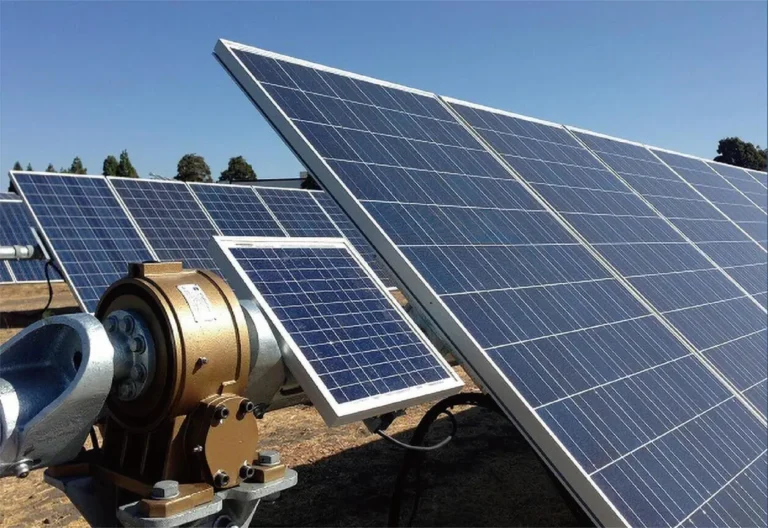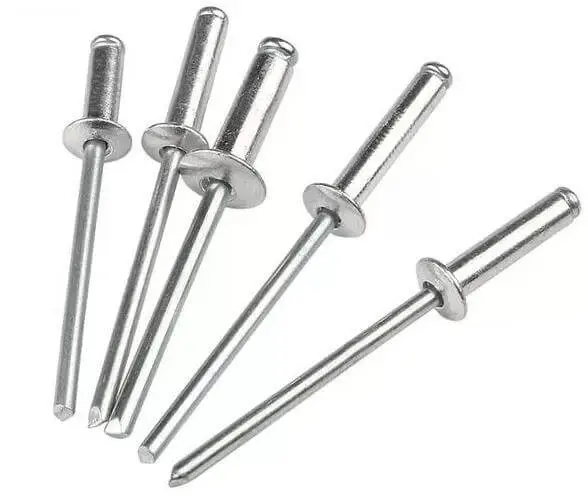How to Choose Blind Rivets for Solar Industry
In the solar photovoltaic industry, blind rivets for solar industry have become key fasteners for connecting metal frames, borders, and installation components. Unlike general industrial environments, photovoltaic systems are exposed outdoors for long periods, facing multiple challenges such as high temperatures, humidity, wind loads, and long-term vibrations. The requirements for fasteners in the solar industry are far higher than those in general mechanical assemblies. This article will conduct an in-depth analysis from five dimensions: material selection, structural type, corrosion resistance, mechanical strength, and installation efficiency. It aims to help you understand how to choose the appropriate blind rivets for solar industry for different photovoltaic scenarios and provide professional suggestions and application solutions from Rivmate.
Table of Contents
Understanding Blind Rivets in Solar Applications

In solar photovoltaic systems, blind rivets for the solar industry play an extremely crucial role in connection. Blind rivets are mechanical fasteners that can be installed from a single side. Their core structure consists of a rivet body and a mandrel. During installation, the mandrel is pulled, causing the tail of the rivet body to undergo plastic deformation, thereby forming a reliable mechanical lock between the workpieces. After the mandrel breaks, it remains inside the rivet body, further enhancing the connection strength and anti-vibration performance.
Blind rivets are widely used in various structural connection scenarios in photovoltaic systems.
- Rapid assembly of support structures: Quick fixation between aluminum alloy profiles to ensure the overall stability of the structure.
- Fixation of component frames: Used for the combination of aluminum frames and connecting parts to ensure that photovoltaic panels do not shift under long-term wind loads.
- Installation of cable trays and windproof clamps: In photovoltaic power stations, blind rivets can achieve lightweight and maintenance-free fastening effects.
Compared with welding and bolted connections, blind rivets have significant advantages:
- Single-sided installation: Particularly convenient in narrow or inaccessible structures.
- Strong vibration resistance: The mechanical locking after riveting effectively resists stress changes caused by wind loads and thermal expansion and contraction.
- Maintenance-free: No need for regular tightening or coating maintenance, suitable for photovoltaic systems with a lifespan of over 25 years.
In addition, blind rivets are not restricted by material types and can be used for connections between various metals such as aluminum, steel, and stainless steel, making them a standardized fastening solution in the manufacturing of photovoltaic racks and modules.
Key Requirements for Choosing Blind Rivets in the Solar Industry
In solar photovoltaic systems, blind rivets are not only fasteners but also an important guarantee for structural reliability. The selection of rivets must simultaneously meet multiple requirements such as durability, strength, weather resistance and installation efficiency. The following are the four key standards for rivets in the photovoltaic industry:
① Superior Corrosion Resistance
The design lifespan of photovoltaic systems is typically over 25 years, and they are exposed to complex environments such as high humidity, acid rain, and salt fog for an extended period. Ordinary aluminum rivets are prone to corrosion under these conditions, leading to loose connections or even failure.

Therefore, it is recommended to use stainless steel rivets (A2/A4 grades) or anodized aluminum rivets, as they can maintain a corrosion-resistant stability of over 1000 hours in the ASTM G85 and ISO 9227 salt spray tests.
This protective performance is particularly crucial for photovoltaic power stations located in coastal areas, deserts or high-salt environments.
② Thermal and UV Resistance
The photovoltaic power station usually operates in a working environment ranging from 70°C to 90°C during summer, and the surface of the components is exposed to intense ultraviolet radiation.
The rivets must have excellent thermal stability and must not loosen due to thermal expansion and contraction. Aluminum alloy and stainless steel rivets perform exceptionally well under thermal cycling conditions, maintaining stable clamping force. At the same time, surface treatment (such as anodization) can prevent ultraviolet aging and extend the service life.
③ Mechanical Strength and Grip Range
The photovoltaic support needs to withstand strong winds, snow loads and long-term vibrations, and has extremely high requirements for the mechanical properties of the fasteners. The rivets should have high shear strength and tensile strength to ensure the stability of the connection point over a long period. It is recommended to use Structural Blind Rivets, whose core shaft locking structure can significantly enhance the vibration resistance and prevent the photovoltaic panel from shifting or the support from losing stability due to loosening.
Furthermore, during the selection process, it is necessary to ensure that the length of the rivets matches the thickness of the material based on the Grip Range.
④ Installation Efficiency and Consistency
The construction of a photovoltaic power station usually involves tens of thousands of connection points. The efficiency of on-site construction directly affects the overall project duration and labor costs.
Using an air riveting gun or cordless electric riveting gun can significantly increase the installation speed and maintain consistent tension output. Compared with traditional manual tools, automated equipment can reduce operational errors and ensure consistent quality at each connection point, which is crucial for large-scale projects.
Best Materials for Blind Rivets in Solar Structures
In solar photovoltaic systems, the selection of the material for the rivets directly affects the lifespan and safety of the structure. As the system is exposed to high temperatures, humidity, sand and salt fog for an extended period, choosing the appropriate material is more crucial than selecting the structural form. The following is an analysis of the performance of several common rivet materials and their recommended applications.
a. Stainless Steel 304 / 316
Stainless steel is the most popular high-end rivet material in the photovoltaic support industry. Its greatest advantage lies in its excellent corrosion resistance and mechanical strength, which ensures stable connection even in environments with salt fog, acid rain and high humidity.
- 304 stainless steel is suitable for regular outdoor applications;
- 316 stainless steel contains molybdenum and can resist corrosion from chlorides, making it particularly suitable for coastal areas or photovoltaic power stations in high salt spray environments.
According to the ASTM B117 salt spray testing standard, 316 stainless steel can remain free of corrosion after 1000 hours of testing, making it the preferred choice for long-term outdoor structures.

b. Anodized Aluminum
Anodic oxidation aluminum rivets possess excellent anti-corrosion properties and lightweight advantages. They are lightweight, easy to install, and are particularly suitable for aluminum profile supports and frame components. Additionally, the anodizing process can form an oxide protective layer on the surface, enhancing resistance to ultraviolet rays and corrosion resistance.
These rivets are commonly used in photovoltaic projects that require moderate strength but are sensitive to cost, such as distributed rooftop power stations.
c. Zinc-Plated Steel
Galvanized steel rivets, due to their high strength and economic efficiency, have become a choice for certain low-cost projects. The galvanized coating can provide short-term corrosion protection, but it is prone to oxidation and peeling in high-salt spray or high-humidity environments.
This type of material is more suitable for indoor or non-coastal photovoltaic applications, and is not recommended for use in areas with high humidity, acidic conditions, or heavy dust.
d. Hybrid Rivets
The composite rivets usually adopt a combined design of aluminum rivet body + stainless steel core shaft. It combines the lightweight property of aluminum with the high strength of steel, making it a solution that balances performance and cost. This design effectively prevents the rivet body from corroding and provides sufficient shear strength, making it highly suitable for the assembly of photovoltaic rails, component fixation, and wind-resistant fixture installation.
Industry Standards Reference
Types of Blind Rivets for Solar Applications
In the solar industry, blind rivets have a variety of applications. A solar panel cannot be stabilized without the use of blind rivets. I will list you some of the commonly used blind rivets in the solar industry.
Blind Rivets for Solar Panel

The installation of solar panels requires the selection of blind rivets of appropriate length, suitable material and weather resistance. The following types of blind rivets are often used for solar panel installation.(Lockbolt Rivet, Bulbtite Rivet, Hemlok Rivet)
Blind Rivets for Solar Tracking Bracket

It takes a lot of strength to hold a solar tracking bracket in place, and many types of blind rivets are needed as well. Commonly used blind rivets are rivet nuts, bulbtite rivets, bom rivets, lockbolt rivet, monobolt rivet, hemlok rivet.
Best Practices for Installing Blind Rivets in Solar Mounting Systems
| Advantages | Reasons to Use Blind Rivets |
|---|---|
| lightweighting | Blind rivets are lighter than welded and bolted connections, contributing to the portability and installation efficiency of solar panels. |
| Structural Strength | Blind rivets provide reliable structural strength to securely fasten solar panels. |
| Preventing Material Damage | The process of installing blind rivets poses a low risk of damage to the solar panel material and does not generate high temperatures or vibrations. |
| Quick and Easy Installation | The installation process of blind rivets is relatively simple and fast, saving installation time and labor costs. |
| Reversibility and Repairability | Blind rivets provide reversible connections for easy removal and replacement of solar panel or racking components. |
FAQ
Q1: What are the best blind rivets for solar panel installation?
In solar photovoltaic installations, the best choice is structural or closed-end blind rivets. These types of rivets have high shear strength and excellent waterproof sealing properties, and can withstand wind loads, vibrations, and rain erosion.
Rivmate suggests using 316 stainless steel structural blind rivets in the photovoltaic support frames and component frameworks to ensure long-term stability and corrosion resistance.
Q2: Are stainless steel rivets necessary for solar structures?
Yes, it is recommended to use stainless steel rivets, especially in outdoor environments. Photovoltaic systems are usually exposed to high temperatures, humidity and ultraviolet rays, and ordinary aluminum or galvanized rivets are prone to rust.
Type 304 stainless steel is suitable for routine projects, while Type 316 stainless steel, due to its molybdenum content, offers superior corrosion resistance in high salt spray, marine or humid hot environments.
Q3: How to prevent rivet corrosion in solar mounting systems?
Q4: Can blind rivets replace bolts in solar supports?
In most photovoltaic installations, blind rivets can partially replace bolt connections, especially for structures with single-sided installation or limited space. Compared to bolts, blind rivets have advantages such as fast installation, resistance to vibration, and maintenance-free. They are highly suitable for fixing photovoltaic supports and frames. However, for areas that require removable or high dynamic loads (such as main structure connections), it is still recommended to retain bolts or use a mixed fastening method.
Power Your Solar Projects with Rivmate Blind Rivets

Selecting the appropriate blind rivets is crucial for ensuring the long-term stability and high reliability of the photovoltaic structure. High-strength and corrosion-resistant rivets not only can withstand extreme climates and wind loads but also significantly reduce the maintenance costs in the later stage.
For solar systems that have been exposed to the elements for more than 25 years, a reliable fastening solution means safer power generation, less downtime for maintenance, and higher return on investment.
Rivmate boasts extensive industry experience and specializes in the design and manufacture of high-performance fasteners for photovoltaic supports, component installation, and cable management systems. Our engineering team provides professional-grade products that comply with ASTM, ISO, and IEC standards to global customers, and offers optimized solutions for different climate conditions.
Whether you are a manufacturer of photovoltaic brackets, an EPC contractor, or a maintenance engineer, Rivmate can provide you with reliable and efficient riveting solutions.
👉 Visit [Rivmate Solar Fastening Center] to learn how we use structural blind rivets and intelligent electric riveting tools to help you achieve faster installation, longer lifespan, and higher reliability in your solar energy project.
Reference
Submit Your Sourcing Request
Please complete the form below and our customer support team will be in touch with you shortly. Inquiries submitted through this form will receive priority processing over emails.




